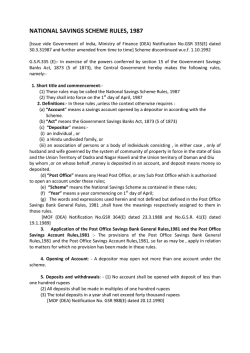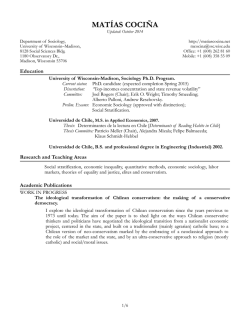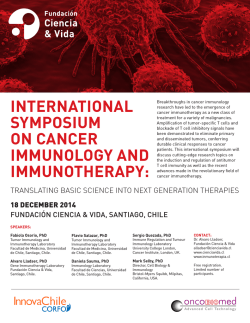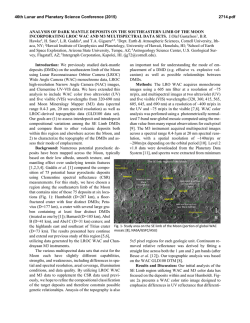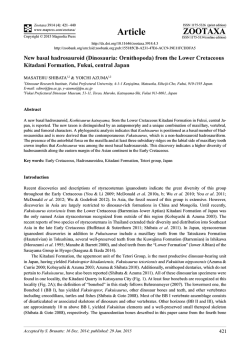
Boris Angelo Cu-(Ag) Deposit, Coastal Cordillera, Central Chile
macla nº 13. septiembre ‘10 revista de la sociedad española de mineralogía 83 Boris Angelo Cu-(Ag) Deposit, Coastal Cordillera, Central Chile. Preliminary Data / JUAN FIGUEROA-CISTERNA (1,*), SALVADOR MORALES-RUANO (1,2), JAVIER CARRILLO-ROSUA (2,3), VERONICA MORENO-RODRIGUEZ (1), MAURICIO RUIZ-CÁRDENAS (4) (1) Departamento de Mineralogía y Petrología. Facultad Ciencias. Universidad de Granada. Avda. Fuentenueva, s/n. 18002, Granada (España) (2) Instituto Andaluz de Ciencias de la Tierra, CSIC-UGR, Facultad Ciencias. Avda. Fuentenueva, s/n. 18002, Granada (España) (3) Dpto. de Didáctica de las Ciencias Experimentales. Facultad de Ciencias de la Educación. Campus de Cartuja. 18071, Granada (España) (4) Minera Las Cenizas S.A. Avda. Humeres 1501, Cabildo, V región de Valparaiso (Chile) INTRODUCTION. METHODOLOGY. The Boris Angelo Cu-(Ag) deposit is located in the easternmost Coastal Cordillera, in Central Chile, between 32º30’ S and 70º40’ W (Fig. 1). It is part of the Cretaceous stratabound Cu-(Ag) deposits belt (Maksaev and Zentilli, 2002), deposits also known as “Chilean Manto-type” Cu-(Ag) deposits. A geological survey was carried out in the Boris Angelo deposit area by Minera Las Cenizas S.A. The aim of this survey was to obtain the first detailed geological map of the mineralized area (Fig. 1), and to establish possible ore mineralization controls. The samples for this preliminary mineralogical and geochemical study come from Boris “Chilean Manto-type” Cu-(Ag) deposits are typical of the first stage of Andean evolution. These deposits are characteristic of an extensional setting of the magmatic arc, along the active margin of South America during Upper Jurassic to Lower Cretaceous (Maksaev and Zentilli, 2002). Angelo stock and volcanoclastic rocks. These samples where taken from the drill-core, recovered from the ore grade zones of the deposits (>1% total copper [CuT]). Samples were analyzed using Xray diffraction (XRD), petrography (transmitted and reflected light microscopy), atomic absorption spectrometry (AAS) for Cu and Ag, and portable X-ray fluorescence (PXRF). Boris Angelo deposit could be one of the youngest deposits from this belt since, according to Rivano (1996), it is hosted, in a volcanoclastic sequence of Lower Cretaceous and by Upper Cretaceous Early Eocene sub-volcanic porphyritic andesitic rocks. By contrast other “Chilean Manto-type” Cu–(Ag) deposits in Central Chile are hosted by sedimentary and volcanic rocks from Jurassic and Lower Cretaceous, and related to coeval and generally barren batholiths (e.g. Maksaev and Zentilli, 2002; Carrillo-Rosúa et al., 2006; Vivallo, 2009). Thus the study of this deposit could give us new insights for the understanding of the metallogenic evolution during Cretaceous times (IOCG and “Chilean Manto-type” Cu-(Ag) deposits generation) and also the transition to Tertiary times (Porphyry Copper deposits generation) in this Andean segment. In this work we present the results of a geological survey and preliminary mineralogical and geochemical studies of the Boris Angelo deposit. fig 1 . Geological map of the Boris Angelo deposit area. palabras clave: Depósitos de Tipo “Manto Chileno”, Cobre resumen SEM 2010 key words: Chile, “Chilean Manto-type” Deposits, Copper * corresponding author: [email protected] 84 BORIS ANGELO DEPOSIT GEOLOGY. The area of the deposit is composed of volcanoclastic sequences, assigned to Lower Cretaceous Las Chilcas Formation (Rivano, 1996). These sequences are intruded by various small sub-volcanic bodies such as stocks and dykes that according to Rivano (1996) are Upper Cretaceous – Paleocene, San Lorenzo Unit. Three different sub-volcanic intrusive units have been recognized (Fig. 1): a) porphyritic Boris Angelo stock, with apparent andesitic composition. b) Soledad stock, with obliterated porphyritic textures c) andesitic dykes, with porphyritic to aphanitic texture. The Boris Angelo stock is intruded by Soledad stock. Finally the dykes cut all volcanosedimentary and intrusive units. These units, with the exception of Soledad stock, show variable mineral alteration, which in hand sample examination is characterized by epidote, chlorite, quartz and hematite. Soledad Stock has a different and strong alteration pattern, where are recognised quartz, clay minerals, epidote and some “box-work” texture filled with Fe oxide. In this study two main different fault trends are recognized (Fig. 1): NS-NNE and EW-NW. These structures constitute en echelon fault system. The ore-bodies have a strong structural control, and are related with these fault zones and dyke intrusions. The oreminerals are hosted by sub-volcanic porphyritic Boris Angelo stock and by the surrounding volcanoclastic rocks. MINERALIZATION. Mineralization occurs mainly in veins and veinlets or fine disseminations in the rock. The ore-minerals are composed mainly by copper sulphides and on the surface also by copper carbonate, such as malachite. The primary ore-mineralogy is characterized by bornite, chalcopyrite and chalcocite, while sphalerite, galena, tetrehedrite–tennantite, are present as accessory phases. Frequently bornite and chalcopyrite show replacement textures (Fig. 2a). Chalcocite commonly shows a simplectitic texture inside the bornite (Fig. 2b). Sphalerite occurs in the border of bornite crystals (Fig. 2c), while galena occurs in small inclusions within bornite. Gangue mineral phases are mainly epidote and chlorite with lesser amounts of quartz and calcite. XRD STUDY. The XRD study reveals a similar diffraction pattern for all the samples. The main mineral phases are quartz, albite and calcite. In relation to clay fraction, chorite and illite are identified. GEOCHEMISTRY. The drill core samples were analyzed by AAS for CuT and Ag, and as well by PXRF, for K, Ca, Sc, Ti, V, Cr, Mn, Fe, Co, Ni, Cu, Zn, As, Rb, Sr, Ag, Cd, Sb and Pb. The CuT grade (AAS) in the ore bodies varies between 1,0% and 12,2% and Ag grade (AAS), varies between 8,0 g/t and 292 g/t. There is a direct correlation between the Cu, Ag, Pb (81 to 1041 ppm), Mn (1385 to 4779 ppm), and Fe (1436 to 471593 ppm) content in the rock. CONCLUSION. The Boris Angelo deposit is interesting since it could be the youngest expression of the Mesozoic “Chilean Manto-type” Cu-(Ag) metallogenic event in Coastal Cordillera. A detailed geochronological study would verify this possibility. fig 2. Textures and occurrences of ore minerals The ore bodies have a strong structural control. They are developed within extensional zones, related to an en echelon faults and dykes system. The authors would like to thank Minera Las Cenizas S.A. for sharing geological information and samples. There is a close relationship between ore mineralization and hydrothermal alteration, mainly characterized by epidote, chlorite, albite, calcite and often by illite. Major (bornite, chalcopyrite and chalcocite) and minor (sphalerite, galena, tetrehedrite - tenantite) ore assemblages are quite similar to other “Chilean Manto-type” Cu-(Ag) deposits (e.g. Carrillo-Rosúa et al., 2006) Ag enrichment (up to 292 g/t), which is associated with Cu, Fe, Mn and Pb increases, has not reflected in the existence of Ag-bearing minerals. Therefore, it is deduced that Ag could be within Cu-sulfides mineral lattices, such as bornite. under reflected light microscope (Bn: bornite; Cc: chalcocite; Ccp: chalcopyrite; Sp: sphalerite). ACKNOWLEDGMENT. REFERENCES. Carrillo Rosúa, J., Morales-Ruano, S., Morata, D., Boyce, A.J., Fallick, A.E., Belmar, M., Munizaga, F., Fenoll Hach-Alí, P. (2006): Mineralogía e isótopos estables en depósitos de Cu-(Ag) estratoligados tipo manto del Cretácico Inferior de la Cordillera de la Costa (área de La Serena y Melipilla). in: “XI Congreso Geológico de Chile”, Antofagasta (Chile), 199-202 Maksaev, V. & Zentilli, M. (2002): Chilean Strata-bound Cu-(Ag) Deposits: An Overview. in “Hydrothermal Iron Oxide Copper-Gold & Related Deposits: A Global Perspective”, Volume 2; Porter, T.M. Ed. ,PGC Publishing, Adelaide, 185-205. Rivano, S. (1996): Geología de la Hojas Quillota y Portillo.1:250.000.Servicio Nacional de Geología y Minería. 191 p. Vivallo, W. (2009): Yacimientos de óxidos de Hierro-cobre-oro en Chile. in “XII Congreso Geológico de Chile abstract book”. Santiago (Chile).
© Copyright 2025
